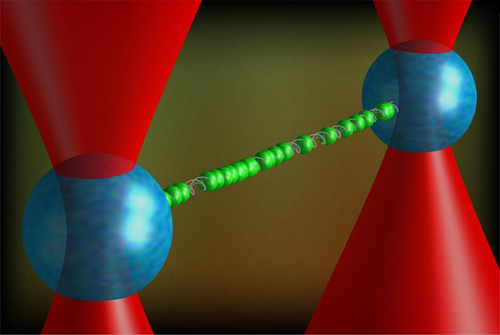Nobel Prize—Lasers as Tools
Lasers are back in the Nobel Prize limelight. This year’s award in physics recognizes the power of lasers to manipulate objects both spatially and temporally. Arthur Ashkin won half of the prize for his invention of optical tweezers, which allow small particles and cells to be maneuvered with light. Sharing the other half of the prize are Gérard Mourou and Donna Strickland, who developed techniques for generating high-intensity laser pulses that can stimulate a target on femtosecond ( 10−15-second) timescales.
The 1964 physics Nobel Prize recognized the invention of the laser. Not long after that, Ashkin, then working at Bell Laboratories in New Jersey, became interested in applying a laser’s intense beam to move small objects directly with the light field, rather than through some effect of laser-generated heat. Light had long been known to exert a radiation pressure on objects, but it was typically too small to observe.
Ashkin performed a series of experiments with micrometer-wide latex spheres suspended in water within a glass cell. He focused an argon laser at the cell and observed that the spheres were pushed to the far end, as expected from radiation pressure models. He also noticed that the spheres became trapped along the beam’s axis. He explained this trapping as resulting from the spatial variation, or gradient, in the beam’s intensity. A light ray passing through the latex sphere is bent due to refraction and leaves the sphere at an angle. This deflection causes the sphere to recoil. In a uniform beam, the net recoil from all of the rays passing through the sphere would be zero, but because the beam center is more intense than the periphery, the result is a pull towards the central axis.
Over the next decade and a half, Ashkin and others experimented with various optical systems that could trap microscale objects, as well as atoms and molecules. In 1986, Ashkin and colleagues developed a single-beam optical trap [2]—a breakthrough that was later given the name “optical tweezers.” This beam is so sharply focused that it produces a gradient force that balances the radiation pressure.
In subsequent years, Ashkin and his collaborators explored uses of optical tweezers in biology. They demonstrated that they could trap and manipulate viruses, living cells, and subcellular components. Later work by other groups showed that optical tweezers could be used to study molecules. In these experiments, the target molecule was tethered to a bead or other object that could be manipulated by optical tweezers. Researchers have used this technique, for example, to measure the tiny forces exerted by molecular motors—such as those that drive muscle contraction—as well as the elastic properties of DNA molecules.
Biologist Karin Schütze worked with Ashkin on optical tweezer experiments to measure molecular motor forces in living cells [3]. She later co-founded a company called CellTool that creates easy-to-use devices that combine optical tweezer technology with spectroscopy for cancer detection and other applications. “Our life’s work depends on Art Ashkin’s inventions,” she says. Steven Chu of Stanford University in California, who received the 1997 physics Nobel Prize for work on atom cooling and trapping, also worked with Ashkin when the two were at Bell Labs. “The impact of optical tweezers in the biological community has been profound, and Art was the pioneer,” Chu says. “I am especially happy that Art got the recognition he deserved.”
The second half of the Nobel Prize also celebrates the usefulness of lasers, not to move things, but to smack them with energy in a short burst. Early efforts at increasing the power in ultrashort laser pulses were stymied by the fact that amplifying such pulses would subject the optical equipment to damaging levels of light intensity. The ingenious method that Mourou and Strickland developed while working at the University of Rochester, New York, in the 1980s, is called chirped pulse amplification (CPA). It involves first stretching out a pulse in time, then amplifying it, and finally compressing it back to its original duration [4]. Because the amplification occurs when the pulse is stretched out, the intensity stays below equipment thresholds until the final compression step.
In their initial demonstration, Mourou and Strickland produced picosecond ( 10−12-second) pulses that delivered around a gigawatt ( 109 watts) of power. Later developments gave 1000-fold improvements, taking durations to femtoseconds and power to terawatts. The dramatic boost in power offered by CPA opened up a myriad of applications in chemistry, industry, and medicine. “Regarding fundamental science, this invention made possible the development of strong-field physics and attosecond [ 10−18-second] science, and it allowed [researchers] to test the idea of laser plasma acceleration of electrons and ions,” says laser expert Sandro De Silvestri from the Polytechnic University of Milan. But the story of CPA isn’t over, as power levels continue to rise. There are now around 50 petawatt-class ( 1015-watt) laser facilities in operation or under development worldwide, with plans that will continue to push laser technology.
This research is published in Physical Review Letters.
–Michael Schirber
Michael Schirber is a Corresponding Editor for Physics Magazine based in Lyon, France.
References
- K. Schakenraad, A. S. Biebricher, M. Sebregts, B. ten Bensel, E. J. G. Peterman, G. J. L. Wuite, I. Heller, C. Storm, and P. van der Schoot, “Hyperstretching DNA,” Nat. Commun. 8, 2197 (2017).
- A. Ashkin, J. M. Dziedzic, J. E. Bjorkholm, and Steven Chu, “Observation of a single-beam gradient force optical trap for dielectric particles,” Opt. Lett. 11, 288 (1986).
- A. Ashkin, Karin Schütze, J. M. Dziedzic, U. Euteneuer, and M. Schliwa, “Force generation of organelle transport measured in vivo by an infrared laser trap,” Nature 348, 346 (1990).
- D. Strickland and G Mourou, “Compression of amplified chirped optical pulses,” Opt. Commun. 56, 219 (1985).





